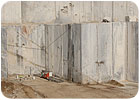

Cosentino’s roots were formed in the 1940s, when Eduarda and Eduardo Cosentino - parents of the current owners of the group - began quarrying and basic processing of marble in Macael. Marmoles Cosentino S.A. was founded in 1979, and the company supplied marble for several landmark building projects in Spain over the course of the 1980s.
Ultimately, the company expanded its operations to include the production of Silestone quartz surfacing in 1990. This product has been used in both residential and commercial spaces, and it has been widely used and promoted for kitchen countertops throughout the U.S.
But even while Cosentino’s Silestone production has enjoyed tremendous growth, the company has also been continually investing in its natural stone operations - including quarries in the Macael region as well as factories for slab and stone tile productions that utilize the latest in stoneworking technology from Italy.
From a distribution point of view, Cosentino is suppliying more than 7,000 stoneworking shops in Europe and America. In Spain, Cosentino owns 15 large warehouses to supply Silestone and natural stone from around the world to local stoneworking shops.

Quarrying operations
Cosentino owns and operates several quarries within Spain, including sites for Marron Emperador and Crema Marfil, which have been popular in the U.S. marketplace.Cosentino began working the site for Marron Emperador marble approximately 30 years ago, and it yields approximately 450 cubic meters of material per month.
The site is a traditional bench quarry, with faces measuring around 20 to 30 feet high. After pilot holes are drilled, diamond wire saws are used to make large vertical cuts. Additionally, Fantini chainsaws are used to make horizontal cuts at the base of the quarry face. After a large block of stone is freed, it is broken down into smaller blocks using hydraulic drills. Final blocks measure approximately 280 x 150 x 150 cm (9 x 5 x 5 feet), and a large inventory of blocks is maintained at the quarry site.
Cosentino purchased the quarry site for Spain’s famed Crema Marfil marble four years ago, and it is estimated that the quarry has 60 years of production in its reserves.
Quarry blocks extracted from the Crema Marfil quarry are slightly larger than those from the Marron Emperador site, measuring 3 m x 150 cm x 150 cm (approximately 10 x 5 x 5 feet). A total of 14 to 15 employees are at work in the quarry.
Other marble varieties processed at Cosentino’s facilities - such as Rojo Alicante and Crema Marfil Royale - are controlled by the company, which in many cases has exclusive access to the materials. By either owning or controlling the quarries, Cosentino feels it is able to ensure a better supply of blocks and can offer its customers a continuous supply of these materials.
Slab production
Cosentino has also upgraded its slab production, and it has developed new product lines in this sector. For example, the SenSa granite collection from Cosentino features slabs that are treated with resin products, and the material also undergoes a proprietary “SenGuard process” to protect the granite from staining. According to the company, SenSa granite also carries a 15-year warranty.The slab production plant at Cosentino features a state-of-the-art resin line from Breton, which operates with resin products from Tenax. During the process, slabs are first placed in a large-scale drier to remove all moisture from the stone and allow for maximum penetration of the resin. The resin is then automatically applied, and a second drier ensures optimum penetration of the resin. Slabs then receive their final polish using Breton polishing lines.
The SenSa marble collection consists of marble, travertine, soapstone and quartzite. The SenSa line also features an exclusive “SenSa touch” finish that is achieved by brushing the surface of the stone with polishing pads during the manufacturing process. This gives the SenSa surface a soft, silky look and feel, and the product has been used for countertops, flooring, walls, fireplace surrounds and other applications.
International operations and markets
In addition to five factories (for both Silestone and natural stone) and 13 quarries for marble and quartz in Spain, Cosentino also has a granite quarry and processing plant in Brazil, which operates under the name Latina Vitória (to be featured in the June 2007 issue of Stone World.) It also has subsidiaries in the Netherlands, the U.K., Germany, Sweden, Portugal and Italy.In the U.S., the company’s subsidiary is C&C North America, which is based in Houston, TX. Additionally, Cosentino has a total of 19 “manufacturing workshops,” including 15 in the U.S. as well as one each in London, England; Mexico City, Mexico; Mammo, Sweden; and Bilbao, Spain.
In all, the Cosentino Group has over 2,060 employees, including 1,059 based in Spain.
A total of 70% of Cosentino’s overall production is exported, and the U.S. is a major market for the company. Among its many marketing efforts, Cosentino can be found at major international trade fairs around the world, with participation in 27 fairs in 2007.